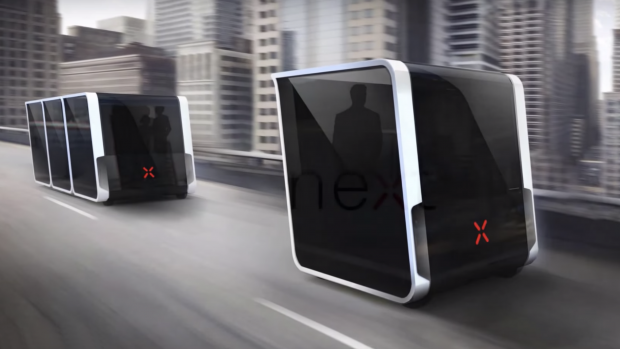What’s Next in Transportation?
Tandon researchers are providing the algorithms driving the systems of the future.

A representation of a modular self-driving vehicle that could make use of Tandon research on routing algorithms. Image source: Next
After Tommaso Gecchelin, the founder of Next Future Transportation, envisioned creating a flexible ride-sharing service that would employ autonomous modular pods, he knew he needed help to formulate the algorithms for routing the pods and distributing the passengers for maximum efficiency and convenience. He turned to NYU Tandon’s Tier 1 U.S. DOT University Transportation Center, C2SMART (Connected Cities with Smart Transportation), where Deputy Director Joseph Chow and then-graduate student Nick Caros got to work developing a heuristic to assign trips to a fleet of Gecchelin’s sleek prototype vehicles. (Caros undertook the project as part of his master’s thesis.) Because the individual pods are capable of smoothly connecting and disconnecting while transporting passengers, organizing riders based on their desired stops, the researchers also needed to be able to determine if and when en-route passenger transfers should take place.
Caros — who began working as a New York City-based transportation planner after earning his master’s degree at Tandon — has presented the results of the research at the 2018 hEART Conference (Symposium of the European Association for Research in Transportation), in Athens, Greece, where he described a multi-day simulation that takes into account three scenarios: door-to-door service within an urban core, long-distance commuter service, and service addressing the commuter first and last miles — as it’s called when a commuter must walk or drive from home to their public transportation stop and then from their destination stop to their workplace. (The work also generated buzz when Gecchelin outlined it during a well-attended Tedx talk.)
The exercise is far from just academic. In 2016, Gecchelin had presented a one tenth-scale prototype of his pod to the Dubai Future Accelerator, greatly impressing the nation’s ruler, Mohammed bin Rashid Al Maktum. At the recent World Government Summit, held in Dubai in February, Gecchelin debuted a pair of full-scale Wi-Fi-enabled pods, each of which can hold 10 people (six seated and four standing), and which can be joined seamlessly together into larger configurations within seconds — even when the pods are in motion — thanks to cameras and electromechanical technologies.
Dubai’s Roads Transport Authority intends to begin testing the system on a wider scale and predicts that a quarter of the country’s public transportation systems will be autonomous by 2030. (Because of its wealth and forward-thinking regulations, Dubai is a good testing ground for new autonomous technology.)
Caros explains that the system offers multiple benefits to commuters, operators, and the general public alike. “For example, a traveler will benefit from not having to wait between transfers, while the operator gains the flexibility to serve more customers, and everyone benefits from a more efficient use of public roadways,” he says.
The industry and academic partners foresee a time when a commuter using the Next Future Transportation app could even summon a pod containing a small-scale coffee shop on demand, much as some trains feature a bar or café car — which some bleary-eyed morning commuters just might consider the biggest benefit of all.




